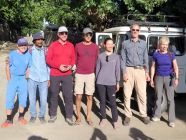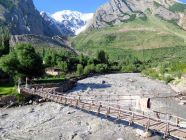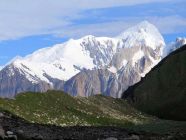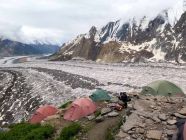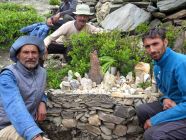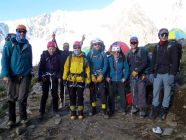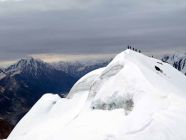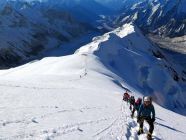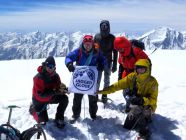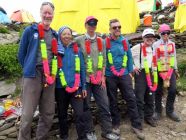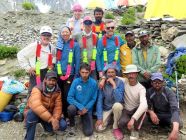I led this trip for Jagged Globe in July 2023. This is a copy of the report written for the Jagged Globe Website.
On 19th July 5 members of the expedition plus 3 local staff reached the summit of Spantik 7027m. Several companies had advertised expeditions to climb Spantik in July 2023, and we expected to meet several teams at Base Camp. In reality we were the only expedition on the mountain apart from 3 individual climbers with small local support crews.
The early season in the Karakoram was marked with heavier than normal Spring snows along with cloudy conditions in June that delayed the start of the summer melting. This meant that there was still some snow in Base Camp when we arrived on 6th July. The rocky ridge between BC and Camp 1 was covered in snow and some of this remained for the few weeks that we were on the mountain. This section, which can usually be climbed in hiking shoes or light boots, needed full mountain boots for almost the whole month of July.
The weather was poor for the first few days in BC delaying the start of the climb. Once it improved our crew of 6 local climbers (Mehidi, Hassan, Shabir, Hussein, Basharat & Ashraf) carried tents, stoves, food and fuel to Camp 1 at 5100m. This enabled the team to climb to Camp 1 and spend their first night on the mountain on 12th July. The weather pattern seemed to be quite unpredictable with days of fine weather often followed by heavy precipitation that fell as rain in BC and snow on the mountain. The weather forecasts were not proving very accurate and there was no sign that we were going to experience a long spell of good weather. We therefore changed our plan from making a summit bid on a third climbing rotation, to going for the top on an extended second rotation.
With supplies and tents already in place at Camp 2 (5680m) the whole team left BC on 15th July and spent the night in Camp 1. The following day we all climbed to Camp 2. The freezing level was a bit higher than we would have wished, but the journey to Camp 2 was not too bad and snow conditions were reasonable. The team enjoyed a rest day on 17th July while the local staff placed approx 1000m of fixed rope on the steep ground between Camp 2 and Camp 3 in hot sunshine. Conditions were again hot and sunny the next day when the team climbed to Camp 3 (6280m). Leaving Camp 2 at 05.30 in the morning enabled us to miss the worst of the heat, although the snow was already soft by 10.30 when we reached Camp 3.
19th July was summit day. Leaving Camp 3 at midnight conditions were cold and clear. For the first time in the entire climb a there was a fairly strong wind blowing and this continued throughout the ascent. Temperatures were not much below zero but the 20-30 knot winds made it feel much colder. The snow surface had not fully frozen and with each step we punched 10-20cm through a breakable crust. The combination of strong winds and crusty snow slowed progress and together added a few hours to the ascent. By the time of first light at 04.00 we had crossed a wide plateau and started onto the steeper ground of the South Ridge. As the light improved it was possible to see down to the glaciers of the Hunza region to the west and make out the deep valley of the Karakoram Highway. After a few hundred meters of 30° climbing the angle eased and the snow slope gave way to a broad ridge of rocks and snow patches. The wind eased slightly and we reached the large level summit expanse about 10.00. Two of the party had turned back a few hours before with two of the local staff, so the summit team comprised 2 guides, 3 climbers and 3 local staff.
After taking some pictures we hurriedly set off for Camp 3 anxious to beat the rapidly rising heat and softening snow. Conditions became unbearably hot as we approached Camp 3 at 14.00. The snow was too soft to descend any further so we all spent a second night at Camp 3. The forecast for the following day was good, but overnight snow continued to fall until mid morning and delayed our intended dawn start. We finally left Camp 3 in a brief weather clearing at 07.45 taking 3 hours to reach Camp 2. The local staff did a heroic job removing all the fixed rope and anchors and bringing this to Camp 2. We then set off together taking another 3 hours to reach Camp 1 in cloudy conditions and softening snow.
The following day everyone was welcomed back to Base Camp by local guide Ali and the cook team who had made a special cake. After a rest day the local climbing staff returned to Camp 1 to remove the last of our equipment from the mountain. The weather continued unsettled and we endured 3 more days of rain in Base Camp. We realized how lucky we had been to take advantage of the short period of good weather to reach the summit.
The porters from Arandu village arrived at Base Camp on the morning of 24th July and we began the two and a half day walk back to the roadhead. From there it was a 6 hour jeep journey to Skardu and some very welcome hot showers. The expedition had finished one day ahead of schedule and the team had a day in Skardu to rest and recover before travelling to Islamabad and on to their various home countries.
On reflection, Spantik is not an ‘easy’ 7000m peak. It is true that the climbing is nowhere difficult but the distances between camps are quite long. Firm snow conditions and good weather would certainly make the climb more straightforward. But soft snow and variable weather seem more usual and these make everything harder. To be successful an expedition needs good planning, resilience and a bit of good luck.
David Hamilton / Skardu / 27th July 2023

